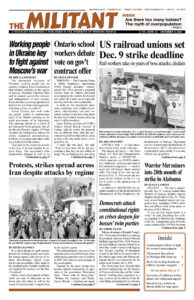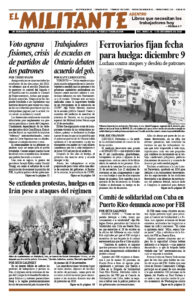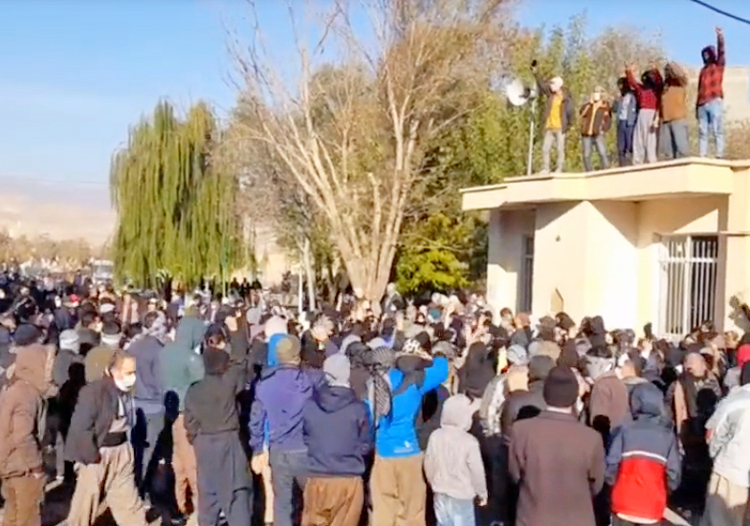In a failed attempt to quell massive protests by working people and youth, the Iranian regime sent convoys of Islamic Revolutionary Guard Corps troops and paramilitary Basij thugs to the predominantly Kurdish northwestern region of the country over the Nov. 19 weekend.
Online videos show protests of thousands and tens of thousands in the towns and cities there as well as the sound of semiautomatic weapons fired by the regime’s agents.
The demonstrations were part of nationwide actions to commemorate those killed during a previous wave of protests in 2019. Their relatives spoke at many of the recent actions.
Funerals for the latest victims have become massive outpourings of opposition to the government. Participants chant, “Down with the dictatorship,” “Women, life, freedom,” and “Kurds, Azeris, Baluch — freedom and equality.” The Kurdish, Azerbaijani and Baluch oppressed minorities in Iran have been special targets of Tehran’s repression.
Over 400 people have been killed since the start of the protests over two months ago. Hundreds have been blinded by rubber bullets and pellets fired by the regime’s agents. The government claims 50 of its security forces have been killed.
Protests began after the Sept. 16 death of a young Kurdish woman, Mahsa Amini, who died three days after she was arrested by the hated “morality” police for violating the rulers’ oppressive dress code. But the Shiite-based bourgeois clerical regime charges the actions are orchestrated by U.S. and Israeli operatives, as well as Iranian Kurdish groups exiled in Iraqi Kurdistan. The Iranian regime’s latest missile and drone attacks into Iraq Nov. 21 hit their bases and an adjacent refugee camp. The airstrikes were condemned by the Kurdistan Regional Government.
The regime ‘fears us’
At the funeral of his son on Nov. 17 in Bukan, Iran, the father of Mohammed Hassanzadeh was cheered by the crowd when he praised the role played by women in the protests. From now on when a man shows courage, he said, “we should say you are very feminine because the courage of women is greater than that of men.”
In Javanrud, a Kurdish town of some 62,000 people, thousands took to the streets to confront a government assault. Despite being fired upon, protesters kept advancing toward the regime’s thugs.
“They say we have weapons, but we are only armed with stones and empty hands,” says one youth in Mahabad, a center of many of the clashes, in a quote posted with a video Nov. 29. “We have nothing else, but they still fear us.”
Etemad (Trust) newspaper in Iran, which supports the “reformist” wing of the capitalist regime, quoted Jalal Mahmoodzadeh, Mahabad’s Member of Parliament, saying that if the troops keep shooting protesters, it will “continue the crisis and increase people’s anger.”
‘Equality for Azeris, Baluch, Kurds’
Students at Tehran University held a solidarity action Nov. 22. They poured red dye into a fountain to symbolize the bloodshed from government attacks. They chanted “Equality for Azeris, Baluch, Kurds”; “Students, teachers, workers, unite, unite”; and “Release the political prisoners.”
Dozens of student leaders, union activists, university professors, and public school teachers have been arrested over the last several weeks as well.
The pro-government Iranian Labour News Agency reports widespread complaints by workers about not being paid on time, the high rate of on-the-job injuries, and the growth in the number of temporary workers who get paid the minimum wage or less and have few protections. As it intensifies its repression, the government is also offering a carrot to workers to encourage them and their unions to refrain from joining protests.
State-financed charities increased the monthly allowance they give to some impoverished families by 30%. Government workers have been given wage increases above the official inflation rate of 42.9%.
Disabled veterans are getting a 25% increase and officials promise special attention to veterans who have been unable to get permanent jobs. Deep-seated anger among working people of all nationalities exists towards the human and financial costs of the regimes decadeslong drive to extend its power through military adventures in Syria, Lebanon, Iraq and beyond.
So far, government concessions have been too little, too late. Hundreds of workers at the Cruise auto plant went on strike Nov. 19 demanding higher wages. That same day workers at the Darugar factory — which manufactures dishwashing liquid and cosmetics — protested. They say the company owes four months of wages and six months of insurance premiums, despite imposing speedup by laying off workers, while keeping production targets the same.
On Nov. 21 strikes began by autoworkers at the Bahman Motor Company in Tehran and “contract” oil workers in Masjid-i Sulaiman, in the predominantly Arab Khuzestan province. Workers at one or two gas complexes in south Pars also struck, saying they had been shorted on their paychecks.
Drivers and other workers at the Tehran airport terminal and other freight companies went on strike the same day, chanting, “Don’t be afraid, we’re all in this together” and “Down with the dictatorship.”
The depth of the support for the protests by working people both in Iran and internationally came through during the World Cup soccer tournament in Qatar. To the applause and cheers of fans at the stadium the Iranian team refused to sing along when Iran’s national anthem was played.
Before the game team captain Ehsan Hajsafi sent a message back home to families who have lost relatives to the regime’s assaults. “They should know that we are with them, we support them and we sympathize with them.”


